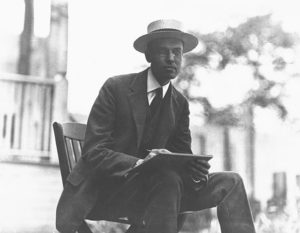Although his most famous work, Nighthawks, sits in the Art Institute of Chicago, Edward Hopper was a distinctly New York artist. He spent much of his life on the Hudson, having been born and raised in Nyack, before living most of his artistic career in Greenwich Village. Last Wednesday, the Whitney Museum of American Art in Lower Manhattan opened a new exhibition called “Edward Hopper’s New York”. The Whitney is especially qualified to put on such a show. When Hopper’s widow Josephine passed away in 1968, she bequeathed her collection of her husband’s art, some three thousand pieces, to the museum. However, some of the show’s items appear to have a rather suspicious provenance.
Reverend Arthayer Sanborn was a Baptist minister in Nyack, NY, who lived just down the road from where Hopper grew up. It seems that Sanborn was close to Josephine Hopper and Hopper’s sister Marion, being one of their caretakers in their later life. So while it makes sense that he would have some Hopper-related documents like photos and letters, it may be a little strange that the minister also had hundreds of his works. At one point, the minister owned more than three hundred works by Hopper, including paintings, drawings, and sketches now housed in major museums. This includes the 1932 painting City Roofs, which Sanborn sold to New York’s Kennedy Gallery and now sits in the Whitney. Sanborn claimed that much of his collection had been personally gifted to him by the Hoppers. He also claimed to have received other works and documents when he bought the contents of Hopper’s Manhattan apartment and his house in Nyack. But some have disputed these claims for decades.
Gail Levin is one of the world’s foremost experts on Edward Hopper. She is one of his biographers, the compiler of his catalogue raisonné, and formerly the curator of his works at the Whitney Museum. Levin has also spent years challenging Reverend Sanborn’s account. She claims that Sanborn took advantage of Edward and Josephine Hopper in their later life, essentially looting works from their properties while they were under his care and immediately after their deaths. She cites inconsistencies in Sanborn’s claims, as well as the fact that the Hoppers recorded when they gifted works to others, records that are lacking regarding Sanborn’s collection. Levin is essentially alleging elder abuse. While Sanborn passed away in 2007, his family continued denying these accusations. Levin also accused the Whitney Museum of failing to take action or say anything regarding the suspicious circumstances of Sanborn’s acquisition of Hopper’s work. According to the Whitney, “The Museum is aware of claims made by a former curator… Those claims were considered when first made and were again researched more recently. The Museum has found no basis to pursue the matter, and is satisfied with what it received.”
If these allegations are to be believed, then the paintings and drawings Sanborn took were not his to profit from; they were meant to be donated to the Whitney. It is unknown how much money Sanborn made by selling his Hopper collection, but paintings like City Roofs are worth millions today. Even some of the drawings are worth hundreds of thousands of dollars, like the charcoal drawing South of Washington Square, which made $437K w/p at Christie’s New York in May 2015.
Along with the exhibition, the Whitney Museum also opened their Hopper Archive to scholars last Wednesday. Much of the archive is made up of documents donated by the Sanborn family. It’s unknown whether access to the archive may shed some light on the ongoing cycle of allegations, but the best we can do is hope.

